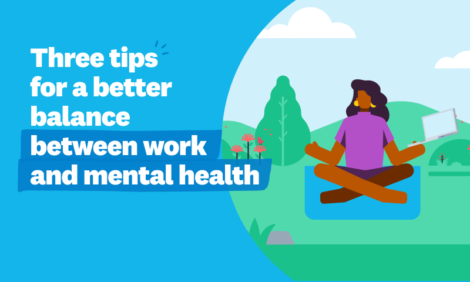
Three tips for a better balance between work and mental health

We know that mental wellbeing is vitally important, but for small business owners, striking a balance between work and mental health can feel almost impossible.
The past two years in particular have thrown up a previously unseen level of disruption and turmoil for small businesses. From the pandemic, to soaring inflation and energy prices, it’s no surprise that finding the time to invest in mental wellbeing is proving challenging.
Our recent study discovered two out of five UK small business owners (40%) believe their business will recover financially before they recover emotionally and mentally from the pandemic. Meanwhile, only around half (55%) know where to turn to get mental health support.
With this in mind, we teamed up with mental health platform Unmind to provide a toolkit offering practical advice to help small business owners manage their mental wellbeing. Here, we’ll break down some of these tips.
Practise mindfulness, if you can
Mindfulness, while not for everyone, is a technique that can be used to support mental health.
If it works for you, it can teach you how to improve your concentration, remove unhelpful thought patterns and redirect your attention in a more purposeful way. If you are able to practise mindfulness, and feel it’s valuable to you, it’s important to remember that it is more effective when carried out regularly.
According to Unmind, there are two main types of mindfulness:
- Closed-focus mindfulness. This trains concentration and quietens the mind by routinely focussing attention back on our current experiences and bodily sensations.
- Open-minded mindfulness. This enhances awareness of what’s going on outside the mind, helping people tune in to their surroundings and override ‘auto-pilot mode’ – a common feeling among business owners that can negatively impact productivity.
It may not always be easy to find the time to practise mindfulness if you’re juggling multiple roles and duties. However, bringing awareness to your thought processes can help you notice and understand negative mental cycles that have developed, and enable you to address them.
Develop a wellbeing-led workplace
For small business owners, staff wellbeing is vital to a healthy business.
Our study found that cost, time and difficulty understanding what support employees want, are significant barriers to embracing wellbeing initiatives.
Here are some simple actions to help your staff feel supported:
- In any induction process, include information around how your business tackles mental health, from mental health first aiders in the office, to forums for non-work discussion. Be sure to provide information about external resources offered by mental health charities such as Mind and support services like The Samaritans.
- Set a positive tone through simple actions such as encouraging full lunch breaks and enforcing defined business hours to avoid overworking. Be sure to adhere to these too, so that you’re setting the right example.
- Have an open line of conversation with team members, speaking regularly to understand how they’re doing and reflect on how the job might be causing them stress.
Manage stress using the container method
Stress affects us all in different ways, with disturbed sleep, anxiety and feeling irritable the most common symptoms of poor mental health. So, how can these symptoms be addressed?
One way is by thinking of your mind as a ‘stress container’. We all have different life experiences and resilience, which means some of our containers are larger, and some are smaller. The stressors in our life flow into the container. When they are manageable, we can drain it slowly by using healthy coping strategies.
Sometimes, the container has too many stressors flowing in and we can’t empty it fast enough. It overflows, resulting in symptoms of stress and poor mental health. Unhealthy coping strategies can block the tap, alleviating the flow of stress.
You can use the stress container concept to balance your mental health, and find a coping strategy to ensure yours doesn’t get too full. This can be achieved in a number of ways, from catching up with friends or family, to exercising.
With these tips, we hope you can begin the journey to creating a more mentally healthy workplace.
To learn more about how you can manage mental wellbeing both for yourself and in your business, check out the full Unmind toolkit.
The post Three tips for a better balance between work and mental health appeared first on Xero Blog.
Source: Xero Blog






